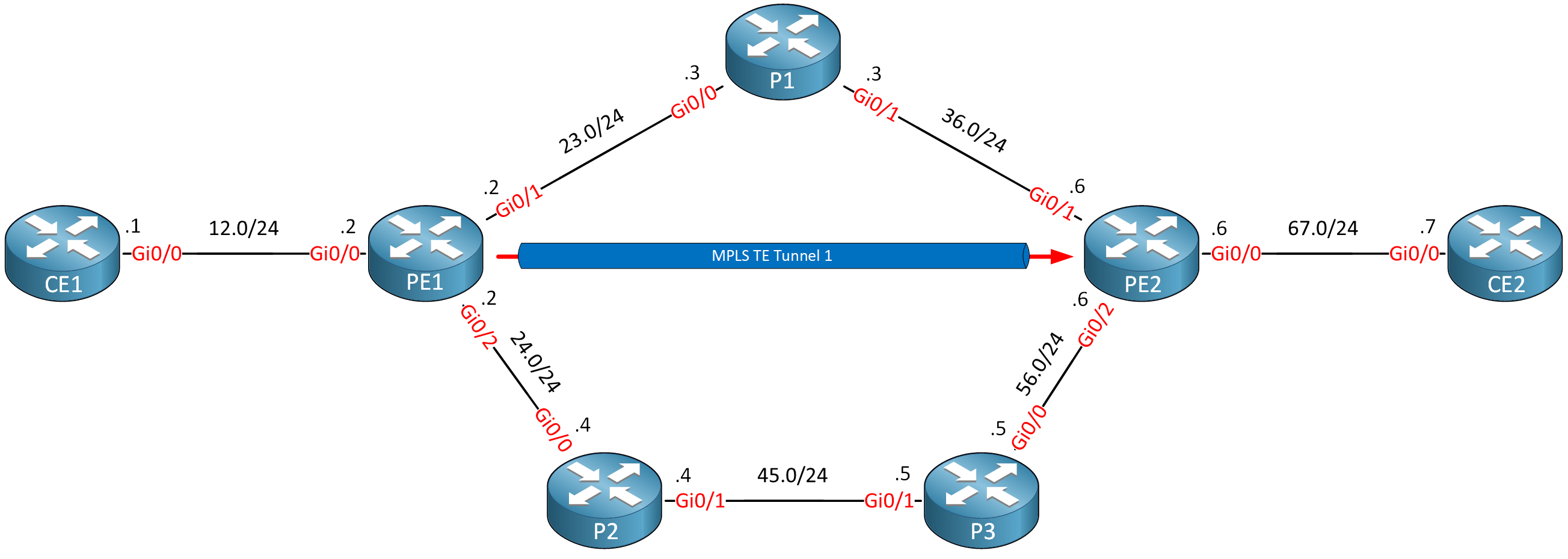In the MPLS Traffic Engineering (TE) IS-IS Configuration lesson and other MPLS TE lessons, I use IS-IS as the IGP on the TE routers. In this lesson, we’ll use OSPF instead.
I’ll walk you through the entire configuration, but because I already explained in detail how to configure an MPLS TE network step-by-step, I’ll only focus on OSPF here. This is the topology we’ll use:

Routers PE1, P1, P2, P3, and PE2 are our MPLS core network. The CE1 and CE2 routers use regular IP routing. All routers are configured to use OSPF area 0 and MPLS is enabled on the interfaces. I use Cisco IOS Software, IOSv Software (VIOS-ADVENTERPRISEK9-M), Version 15.9(3)M4.
Configurations
Want to take a look for yourself? Here, you will find the startup configuration of each device.
CE1
hostname CE1
!
ip cef
!
interface Loopback0
ip address 1.1.1.1 255.255.255.255
!
interface GigabitEthernet0/0
ip address 192.168.12.1 255.255.255.0
!
router ospf 1
network 1.1.1.1 0.0.0.0 area 0
network 192.168.12.0 0.0.0.255 area 0
!
endCE2
hostname CE2
!
ip cef
!
interface Loopback0
ip address 7.7.7.7 255.255.255.255
!
interface GigabitEthernet0/0
ip address 192.168.67.7 255.255.255.0
!
router ospf 1
network 7.7.7.7 0.0.0.0 area 0
network 192.168.67.0 0.0.0.255 area 0
!
endP1
hostname P1
!
ip cef
!
interface Loopback0
ip address 3.3.3.3 255.255.255.255
!
interface GigabitEthernet0/0
ip address 192.168.23.3 255.255.255.0
mpls ip
!
interface GigabitEthernet0/1
ip address 192.168.36.3 255.255.255.0
mpls ip
!
router ospf 1
network 3.3.3.3 0.0.0.0 area 0
network 192.168.23.0 0.0.0.255 area 0
network 192.168.36.0 0.0.0.255 area 0
!
mpls ldp router-id Loopback0 force
!
endP2
hostname P2
!
ip cef
!
interface Loopback0
ip address 4.4.4.4 255.255.255.255
!
interface GigabitEthernet0/0
ip address 192.168.24.4 255.255.255.0
mpls ip
!
interface GigabitEthernet0/1
ip address 192.168.45.4 255.255.255.0
mpls ip
!
router ospf 1
network 4.4.4.4 0.0.0.0 area 0
network 192.168.24.0 0.0.0.255 area 0
network 192.168.45.0 0.0.0.255 area 0
!
mpls ldp router-id Loopback0 force
!
endP3
hostname P3
!
ip cef
!
interface Loopback0
ip address 5.5.5.5 255.255.255.255
!
interface GigabitEthernet0/0
ip address 192.168.56.5 255.255.255.0
mpls ip
!
interface GigabitEthernet0/1
ip address 192.168.45.5 255.255.255.0
mpls ip
!
router ospf 1
network 5.5.5.5 0.0.0.0 area 0
network 192.168.45.0 0.0.0.255 area 0
network 192.168.56.0 0.0.0.255 area 0
!
mpls ldp router-id Loopback0 force
!
endPE1
hostname PE1
!
ip cef
!
interface Loopback0
ip address 2.2.2.2 255.255.255.255
!
interface GigabitEthernet0/0
ip address 192.168.12.2 255.255.255.0
!
interface GigabitEthernet0/1
ip address 192.168.23.2 255.255.255.0
mpls ip
!
interface GigabitEthernet0/2
ip address 192.168.24.2 255.255.255.0
mpls ip
!
router ospf 1
network 2.2.2.2 0.0.0.0 area 0
network 192.168.12.0 0.0.0.255 area 0
network 192.168.23.0 0.0.0.255 area 0
network 192.168.24.0 0.0.0.255 area 0
!
mpls ldp router-id Loopback0 force
!
endPE2
hostname PE2
!
ip cef
!
interface Loopback0
ip address 6.6.6.6 255.255.255.255
!
interface GigabitEthernet0/0
ip address 192.168.67.6 255.255.255.0
!
interface GigabitEthernet0/1
ip address 192.168.36.6 255.255.255.0
mpls ip
!
interface GigabitEthernet0/2
ip address 192.168.56.6 255.255.255.0
mpls ip
!
router ospf 1
network 6.6.6.6 0.0.0.0 area 0
network 192.168.36.0 0.0.0.255 area 0
network 192.168.56.0 0.0.0.255 area 0
network 192.168.67.0 0.0.0.255 area 0
!
mpls ldp router-id Loopback0 force
!
endBefore we continue, let’s make sure we have a label-switched path (LSP) when we send traffic from CE1 to CE2:
CE1#traceroute 7.7.7.7 source 1.1.1.1 probe 1
Type escape sequence to abort.
Tracing the route to 7.7.7.7
VRF info: (vrf in name/id, vrf out name/id)
1 192.168.12.2 1 msec
2 192.168.23.3 [MPLS: Label 23 Exp 0] 4 msec
3 192.168.36.6 [MPLS: Label 19 Exp 0] 3 msec
4 192.168.67.7 4 msecThe LSP is working.
Configuration
Let’s configure this “regular” MPLS network into a network that supports MPLS TE. There are four main items we have to configure:
- Enable MPLS TE support:
- Configure OSPF to support MPLS TE.
- Configure RSVP.
- Configure a TE tunnel interface.
We configure these items on all MPLS routers where you want to use MPLS TE. Let’s get started.
Global
The global mpls traffic-eng tunnels command enables MPLS TE globally:
PE1, P1, P2, P3, and PE2
(config)#mpls traffic-eng tunnelsInterfaces
We have to enable MPLS TE support on all interfaces that connect the PE and P routers:

This is the configuration:
PE1 and PE2
(config)#interface range GigabitEthernet 0/1 - 2
(config-if-range)#mpls traffic-eng tunnelsP1, P2, and P3
(config)#interface range GigabitEthernet 0/0 - 1
(config-if-range)#mpls traffic-eng tunnelsThat’s all you need.
OSPF
There are two things we need to configure for OSPF to support MPLS TE:
- Enable MPLS TE for the area.
- Configure the router ID.
Here’s how to do it:
PE1, PE2, P1, P2 & P3
(config)#router ospf 1
(config-router)#mpls traffic-eng area 0
(config-router)#mpls traffic-eng router-id loopback 0RSVP
Let’s configure RSVP to use up to the interface bandwidth:
PE1 and PE2
(config)#interface range GigabitEthernet 0/1 - 2
(config-if-range)#ip rsvp bandwidth 1000000P1, P2, and P3
(config)#interface range GigabitEthernet 0/0 - 1
(config-if-range)#ip rsvp bandwidth 1000000Tunnel Interface
Let’s configure a tunnel interface between PE1 and PE2:

This is how you configure a tunnel interface:
PE1(config)#interface Tunnel 1
PE1(config-if)#ip unnumbered Loopback 0
PE1(config-if)#tunnel mode mpls traffic-eng
PE1(config-if)#tunnel destination 6.6.6.6
PE1(config-if)#tunnel mpls traffic-eng bandwidth 750
PE1(config-if)#tunnel mpls traffic-eng path-option 1 dynamicVerification
Everything is now configured. This network should be ready for MPLS TE. Let’s find out.
Source link

Leave a Reply